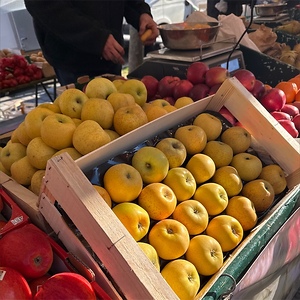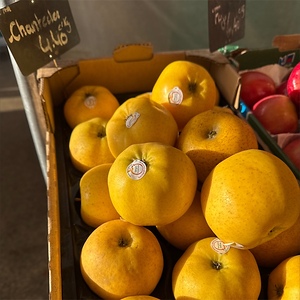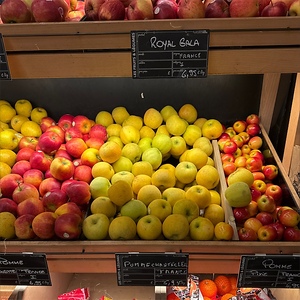


Chantecler Apples
Estimated Inventory, lb : 0
Description/Taste
Chantecler apples are a medium to large varietal, averaging 7 to 9 centimeters in diameter, and vary in shape from round, conic, to oblate with flattened ends. The variety exhibits some ribbing and has a rustic appearance. The skin ripens from green to matte, golden-yellow hues and is enveloped in prominent dots called russet lenticels, giving the surface a semi-rough feel. The skin is also occasionally flushed with light patches of red-orange blush. Underneath the surface, the cream-colored flesh has some density and is initially firm, crisp, and aqueous, softening with age into a floury consistency. The flesh also encases a central fibrous core filled with tiny black-brown seeds. Chantecler apples emit a perfumed aroma and are said to have sweet, fruity, and honeyed nuances. The variety is edible raw once ripe and has a delicate, balanced flavor of sugar and acidity, creating a clean, refreshing, sweet, and sour taste with vanilla, pear, and floral notes.
Seasons/Availability
Chantecler apples are harvested in the late fall through early winter, typically in late September or October. Once picked, the variety is professionally stored and sold into the spring.
Current Facts
Chantecler apples, botanically classified as Malus domestica, are a French variety belonging to the Rosaceae family. The golden apples grow on deciduous trees reaching 4 to 5 meters in height and are a late season variety, ready for harvest approximately two weeks after Golden Delicious apples, one of its parent varieties. Chantecler apples are sometimes known under the trademarked name Belchard® in France and are also sold under spelling variations, including Chanteclerc and Chantecler Belchard. The name Chantecler is said to have been created from the French words “chanter,” meaning “to sing,” and “cler,” meaning “clearly or loudly.” This moniker embodies the variety’s bright coloring and flavor. Growers value Chantecler apples as a commercial cultivar because of their large and consistent annual yields. The variety is typically harvested 2 to 3 times over several weeks, and the apples are sold in fresh markets as a dual-purpose cultivar. Chantecler apples are sought by chefs and home cooks for their ability to be eaten fresh or cooked in a wide array of sweet or savory culinary preparations.
Nutritional Value
Chantecler apples have not been extensively studied for their nutritional properties. Apples, in general, are a source of antioxidants to reduce inflammation and vitamins A, B, C, E, and K to maintain healthy organs, strengthen the immune system, and guard the cells against the damage caused by free radicals. Apples also provide minerals like potassium, calcium, iron, phosphorus, and magnesium. Potassium balances fluid levels within the body, calcium and phosphorus protect bones and teeth, iron develops the protein hemoglobin for oxygen transport through the bloodstream, and magnesium helps control nerve functions. Other nutrients include fiber to support the digestive tract, manganese, and copper.
Applications
Chantecler apples have a balanced, sweet, and subtly tart taste suited for fresh and cooked preparations. When sliced, the variety is slow to brown, making it a popular ingredient in salads, fruit medleys, and charcuterie boards. Chantecler apples are commonly layered and heated with Comté cheese on a baguette as a snack in France. The variety can also be used as a fresh garnish over oatmeal, grain bowls, and other breakfast dishes. In addition to fresh preparations, Chantecler apples hold their shape when cooked and are frequently incorporated into baked goods and desserts. The variety is ideal for tarts, pies, crumbles, cakes, and muffins. They are also stuffed and baked whole, pan-fried, or simmered into compotes, jams, and jellies. Beyond sweet dishes, Chantecler apples are used in savory recipes to accompany roasted meats and root vegetables. They are also pressed into juice or made into cider as a refreshing beverage. Chantecler apples pair well with nuts such as walnuts, pecans, and almonds, meats including pork, poultry, and turkey, and herbs such as mint, cilantro, parsley, and rosemary. Whole, unwashed Chantecler apples will keep for several weeks to months when stored in a cool, dry, and dark location such as a cellar or the refrigerator’s crisper drawer. In professional cold storage, the variety can last between 2 to 5 months.
Ethnic/Cultural Info
Chantecler apples are one of several commercial apples released by France’s National Institute for Agricultural Research, commonly abbreviated as INRA. The INRA was established in 1946 to conduct environmental and agricultural research. During the late 1940s, France suffered from food shortages caused by World War II. The INRA was created as a part of a movement often called “Feeding France” to help meet the demand for improved varieties to aid French growers in production. By the 1960s, the INRA had contributed considerable advancements in agriculture that led France to be self-sufficient in growing food. The INRA continued to research, breed, and evaluate new crops in the 21st century, and by 2006, they were considered one of Europe’s primary agricultural research organizations. In regards to apples, the INRA has helped create commercial varieties, including Chantecler, Choupette®, Ariane, and Story®, also known as Inored. In 2020, the INRA was merged with the National Research Institute of Science and Technology for the Environment and Agriculture, or IRSTEA, to create the INRAE. This institute is still active in agricultural research in the present day.
Geography/History
Chantecler apples are native to France and were developed in the mid-20th century through the INRA, or the French National Institute for Agricultural Research. INRA was based in the city of Angers in western France at the time of the Chantecler apple’s development, and the variety was created from a cross between Golden Delicious apples and Reinette Clochard apples. Chantecler apples were bred in 1958 from the desire to create a new variety with improved shelf life, flavor, and a productive nature. By 1977, Chantecler apples had been released to select commercial growers and were featured in French nursery catalogs as a protected specialty apple. The variety later became publicly available in 2011 for widespread availability. Today, Chantecler apples are grown throughout France, especially in the Loire Valley. The variety is also grown in home gardens and produced on a small scale in other parts of Europe. When in season, Chantecler apples are sold directly through growers, local markets, specialty retailers, and supermarkets.










